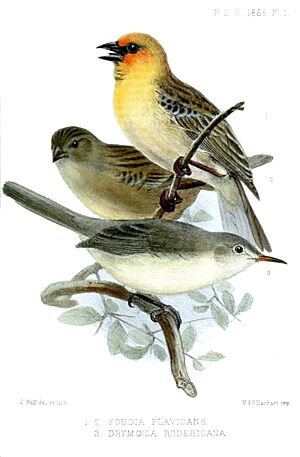Rodrigues fody facts for kids
Quick facts for kids Rodrigues fody |
|
|---|---|
 |
|
| Illustrations by Joseph Wolf (1864) | |
| Conservation status | |
| Scientific classification | |
| Genus: |
Foudia
|
| Species: |
flavicans
|
The Rodrigues fody (Foudia flavicans) is a small, rare bird. It belongs to the weaver family. This special bird lives only on Rodrigues, an island that is part of Mauritius. Experts say it is a vulnerable species. This means it needs help to survive. It is also listed as endangered in the United States.
Contents
Rodrigues Fody: A Special Island Bird
What Does the Rodrigues Fody Look Like?
This bird is about 12 to 13 centimeters long. That's about the length of a small pencil. It has bright yellow feathers. Its face is a pretty orange color. Its back, wings, and tail are brown.
Where Does It Live and What Does It Eat?
The Rodrigues fody lives high up in the trees. It prefers the tops of trees that are at least 5 meters tall. Sometimes, these birds travel together in groups. They like to live near Norfolk Island pine trees. They also like areas with many different kinds of tall, dense trees.
The Rodrigues fody eats many different things. It enjoys insects and spiders. It also eats seeds, sweet nectar from flowers, and fruit.
Why Was the Rodrigues Fody in Trouble?
A long time ago, there were many Rodrigues fodies on the island. But by 1968, only about 5 or 6 pairs were left. This meant they were almost gone forever.
The biggest problem for these birds was losing their forest home. People cut down trees to make farms. They also cleared land for their animals to graze. Another problem is a bird called the Madagascar red fody. This bird was brought to the island and competes with the Rodrigues fody for food. Strong storms called Cyclones and dry periods called droughts also make it hard for them to find enough food.
How Are People Helping the Rodrigues Fody?
Many people have worked hard to help the Rodrigues fody. They have planted new trees to rebuild the forests. This effort has helped the fody population grow. By 1999, there were between 911 and 1200 of these birds. Fences have also been built to keep farm animals out of the forests. This protects the young trees and the birds' homes.


